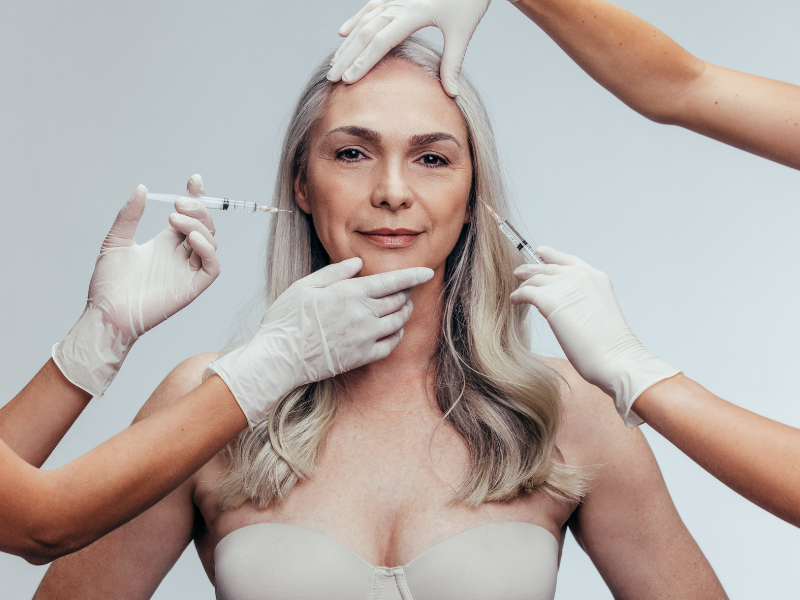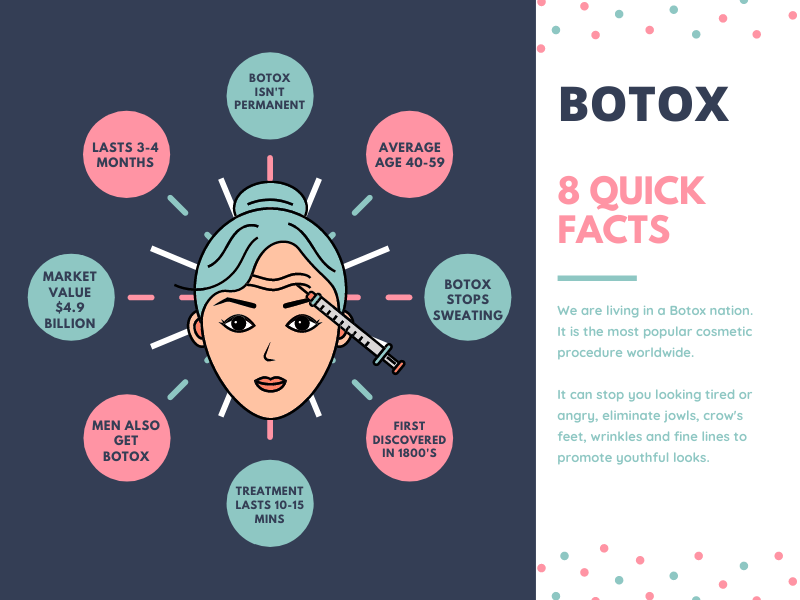
Thinking about having Botox? Already having Botox but still have questions? If you are reading this, you will undoubtedly be familiar with what Botox has to offer – for better or worse. From eliminating wrinkles and worry lines, battling crows feet to turkey necks or, helping alleviate migraines, Botox is the #1 choice for altering and enhancing cosmetic appearance.
Whether you are a Botox newbie or Botox veteran, the injecting of a botulinum toxin into the body to slow down the hands of time is for sure an odd concept and something definitely open for debate. Whatever your standpoint is, there is no denying how rapidly its popularity is increasing.
Botox – The New Normal?
Globally, the facial injectable market size was estimated at $13.4 billion in 2020 and is expected to reach $15.3 billion in 2021.
According to the American Board of Cosmetic Surgery, Botox injections are the most popular cosmetic procedure and in the UK, a poll by Glamour magazine found that by 2020, it’s estimated that almost 1.5 million women in the UK will opt for nonsurgical cosmetic treatments such as Botox or fillers. Could these figures be conservative? I think so.
Allure magazine looked at the most common plastic surgery trends for 2020 which included procedures such as chin fillers, eyebrow tattooing and smaller breast implants. However, still top of the league board was Botox. One specific trend predicted are Botox facials, in which a trained beautician uses a diluted form of botulinum toxin along with microneedling to help give the skin a ‘smooth and radiant appearance’. The new norm – I think so!
Botox For All Ages
No doubt, we are living in a Botox nation. And it isn’t just for Gen X baby boomers either. Thanks to the Kardashianesque style lives many aspire to lead nowadays, Botox is as accepted as gravy with a Sunday roast for all age groups and genders. Gen X and millennials are jumping on board with an average age for Botox patients typically starting at age 30. Preventative Botox is also a thing with the mid-20s being the starting point for helping to keep young and beautiful.
Without a doubt, Botox is certainly redefining the aging process.
The option to spend money on nonsurgical cosmetic treatments is driven by the same motivation…..to stay looking young. The desire to drink from the fountain of youth and hold onto our beauty isn’t a new phenomenon, its an age old human conundrum that no-one has ever mastered – albeit Botox is doing a pretty good job of helping us all live in a Neverland existence when it comes to aging.
The reality is, Botox is here to stay so why not do yourself a favour and learn all you can about it. Better the devil you know right?!
Botox: Quick Fact Checker

Still hungry to know more? Here are 5 commonly asked questions about Botox.
#1 How Long Does It Take For Botox To Work?
Botox is a neuromodulator, meaning that it works to relax the muscle and reduce its ability to function as well as it would normally, thereby restricting movement. This restriction of movement helps reduce fine lines and wrinkles. Generally, the first sign of results can be witnessed within the first few days (between 2-5 days) but it can take up to 1-2 weeks to reveal the full effects.
This is due to the time it takes for the body to start reacting to the Botox after it’s been injected. Oftentimes, Botox practitioners will ask patients to return within 2 weeks of their treatment so that they can monitor the progress.
Because it takes up to 2 weeks to show the full effect, it is important to wait an adequate amount of time before considering a top-up treatment.
Other considerations that may affect how long Botox takes to work include differences between individuals physical and biological make up. For example, people with strong facial muscles may take a little longer to react to Botox injections and the effects are slower. Also, people with aged crows feet, deep wrinkles or heavy burrow lines who are perhaps choosing to experience Botox later in life, may need more than just their primary injection to see the kind of results that they are hoping for. Expectation versus reality should be something to raise and discuss in your first consultation with your Botox provider.
It is also important to note that if you are getting Botox for a special occasion, allow several weeks ahead of time so that you can have your initial consultation and treatment at least 2-weeks in advance so that you can fully enjoy optimal results.
#2 Can You Drink After Botox?
In short, the answer is yes. Drinking alcohol after you have had Botox is fine and will not affect the results. The caveat?
Everyone reacts differently to things so caution should be taken.
The first time you have Botox will help you establish ‘how’ you react to it. If it’s obvious that you react positively without any side effects, it is likely OK to consume alcohol after subsequent sessions as you normally would, though moderate consumption is always recommended to ensure your health and wellbeing are not compromised.
#3 Can You Lay Down After Botox?

Now this one surprised me. Aftercare advice for Botox treatments recommend that you should not lay down for at least 4-6 hours after having a Botox procedure.
Several reasons are cited namely that it will help to prevent any excessive swelling as well as stop Botox spreading to other areas around the injection site that could lead to unwanted muscle weakness. A good option would be to have a treatment in the morning, and stay upright for the remainder of the day going about your usual tasks.
#4 How Often To Get Botox?
Newsflash….Botox isn’t permanent.
Results typically last on average for around 12 weeks. As such, most people have Botox treatments every 3-4 months. That said, some people are blessed with facial muscles that begin to self-train to contract less and therefore, the time between each treatment will extend beyond 3-4 months.
Research has also demonstrated that after a couple of years of regular Botox injections, good results may last with less frequent treatments. One study showed how 50 women aged between 30-50 years old, who had received Botox every 4 months over a 2-year period, could successfully reduce the frequency of treatments to every six months with almost similar results as with the more frequent treatments. Thus, patients can potentially cut the frequency – and obviously the cost also (whoop whoop) – of Botox treatments by half.
Where Does Botox Go When It Wears Off?
Botox does not have a systematic effect meaning it doesn’t travel to other tissues distant from the original injection site. Once Botox has been injected, it does not travel through your body. It can only move up to approx. 3cm from where it was injected. So Botox in your face will not be found lower down in your body.
It works by attaching itself to the nerve ending preventing muscles from contracting. Generally, it takes about 3-6 months for the effects of Botox to wear off as the body metabolizes Botox through the liver and kidney excretion.
Botox: The Take Home

The multi-billion dollar Botox industry is estimated to increase significantly in the coming years, so if you are considering investing in something, this could well be your answer. The positive effects of Botox cannot be denied.
However, as with any cosmetic procedure, there are risks involved. We have all seen cosmetic surgery horror stories of when things go wrong, so this is not a decision that you take lightly without doing your homework and checks first. Being Botox savvy is essential so we hope that these questions have whet your appetite to discover more about this controversial treatment that so many people cannot live without.
If you enjoyed this why not try this:
